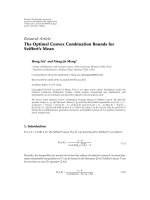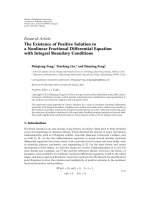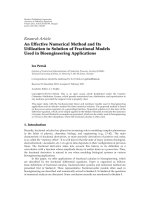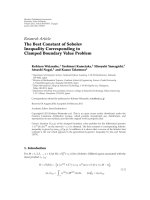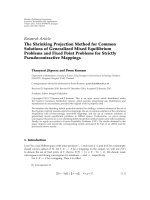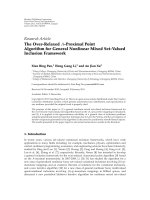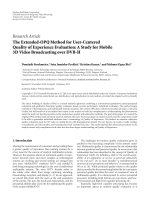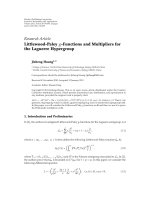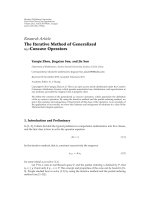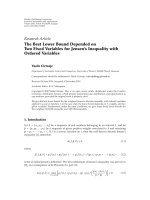Báo cáo hóa học: " Research Article The Generalized Gronwall Inequality and Its Application to Periodic Solutions of Integrodifferential Impulsive Periodic System on Banach Space" potx
Bạn đang xem bản rút gọn của tài liệu. Xem và tải ngay bản đầy đủ của tài liệu tại đây (565.24 KB, 22 trang )
Hindawi Publishing Corporation
Journal of Inequalities and Applications
Volume 2008, Article ID 430521, 22 pages
doi:10.1155/2008/430521
Research Article
The Generalized Gronwall Inequality
and Its Application to Periodic Solutions of
Integrodifferential Impulsive Periodic
System on Banach Space
JinRong Wang,
1
X. Xiang,
1, 2
W. W ei,
2
and Qian Chen
2
1
College of Computer Science and Technology, Guizhou University, Guiyang, Guizhou 550025, China
2
College of Science, Guizhou University, Guiyang, Guizhou 550025, China
Correspondence should be addressed to JinRong Wang,
Received 27 June 2008; Accepted 29 September 2008
Recommended by Ond
ˇ
rej Do
ˇ
sl
´
y
This paper deals with a class of integrodifferential impulsive periodic systems on Banach space.
Using impulsive periodic evolution operator given by us, the T
0
-periodic PC-mild solution is
introduced and suitable Poincar
´
e operator is constructed. Showing the compactness of Poincar
´
e
operator and using a new generalized Gronwall’s inequality with impulse, mixed type integral
operators and B-norm given by us, we utilize Leray-Schauder fixed point theorem to prove the
existence of T
0
-periodic PC-mild solutions. Our method is much different from methods of other
papers. At last, an example is given for demonstration.
Copyright q 2008 JinRong Wang et al. This is an open access article distributed under the Creative
Commons Attribution License, which permits unrestricted use, distribution, and reproduction in
any medium, provided the original work is properly cited.
1. Introduction
It is well known that impulsive periodic motion is a very important and special phenomenon
not only in natural science, but also in social science such as climate, food supplement,
insecticide population, and sustainable development. Periodic system with applications
on finite-dimensional spaces has been extensively studied. Particularly, impulsive periodic
systems on finite-dimensional spaces are considered and some important results such as the
existence and stability of periodic solution, the relationship between bounded solution and
periodic solution, and robustness by perturbation are obtained see 1–4.
Since the end of last century, many researchers pay great attention to impulsive
systems on infinite-dimensional spaces. Particulary, Ahmed et al. investigated optimal
control problems of system governed by impulsive system see 5–8. Many authors
including us also gave a series of results for semilinear integrodifferential, strongly
nonlinear impulsive systems and optimal control problems see 9–20.
2 Journal of Inequalities and Applications
Although, there are some papers on periodic solution for periodic system on infinite-
dimensional spaces see 12, 21–23 and some results discussing integrodifferential system
on finite Banach space and infinite Banach space see 11, 13. To our knowledge, inte-
grodifferential impulsive periodic systems on infinite-dimensional spaces with unbounded
operator have not been extensively investigated. Recently, we discuss the impulsive
periodic system and integrodifferential impulsive system on infinite-dimensional spaces.
Linear impulsive evolution operator is constructed and T
0
-periodic PC-mild solution is
introduced. The existence of periodic solutions, alternative theorem criteria of Massera
type, asymptotical stability, and robustness by perturbation is established see 24–26.
For semilinear impulsive periodic system, a suitable Poincar
´
e operator is constructed which
verifies its compactness and continuity. By virtue of a generalized Gronwall inequality with
mixed integral operator and impulse given by us, the estimate of the PC-mild solutions is
derived. Some fixed point theorems such as Banach fixed point theorem and Horn fixed point
theorem are applied to obtain the existence of periodic PC-mild solutions, respectively see
27, 28. For integrodifferential impulsive system, the existence of PC-mild solutions and
optimal controls is presented see 15.
Herein, we go on studying the following integrodifferential impulsive periodic system
˙xtAxtf
t, x,
t
0
gt, s, xds
,t
/
τ
k
,
ΔxtB
k
xtc
k
,t τ
k
.
1.1
on infinite-dimensional Banach space X, where 0 τ
0
<τ
1
<τ
2
< ···<τ
k
···; lim
k →∞
τ
k
∞,
τ
kδ
τ
k
T
0
; Δxτ
k
xτ
k
− xτ
−
k
, k ∈ Z
0
; T
0
is a fi xed positive number; and δ ∈ N
denoted t he number of impulsive points between 0 and T
0
. The operator A is the infinitesimal
generator of a C
0
-semigroup {Tt,t≥ 0} on X; f is a T
0
-periodic, with respect to t ∈ 0
∞, Carath
´
edory function; g is a continuous function from 0, ∞ × 0, ∞ × X to X and is
T
0
-periodic in t and s;andB
kδ
B
k
, c
kδ
c
k
. This paper is mainly concerned with the
existence of periodic solutions for integrodifferential impulsive periodic system on infinite-
dimensional Banach space X.
In this paper, we use Leray-Schauder fixed point theorem to obtain the existence of
periodic solutions for integrodifferential impulsive periodic system 1.1. First, by virtue
of impulsive evolution operator corresponding to linear homogeneous impulsive system,
we construct a new Poincar
´
e operator P for integrodifferential impulsive periodic system
1.1, then we overcome some difficulties to show the compactness of Poincar
´
e operator P
which is very important. By a new generalized Gronwall inequality with impulse, mixed-
type integral operators, and B-norm given by us, the estimate of fixed point set {x λPx, λ ∈
0, 1} is established. Therefore, the existence of T
0
-periodic PC-mild solutions for impulsive
integrodifferential periodic system is shown.
In order to obtain the existence of periodic solutions, many authors use Horn fixed
point theorem or Banach fixed point theorem. However, the conditions for Horn fixed point
theorem are not easy to be verified sometimes and the conditions for Banach fixed point
theorem are too strong. Our method is much different from others’, and we give a new
way to show the existence of periodic solutions. In addition, the new generalized Gronwall
inequality with impulse, mixed-type integral operator, and B-norm given by us, which can
be used in other problems, have played an essential role in the study of nonlinear problems
on infinite-dimensional spaces.
JinRong Wang et al. 3
This paper is organized as follows. In Section 2, some results of linear impulsive
periodic system and properties of impulsive periodic evolution operator corresponding to
homogeneous linear impulsive periodic system are recalled. In Section 3, the new generalized
Gronwall inequality with impulse, mixed-type integral operator, and B-norm are established.
In Section 4,theT
0
-periodic PC-mild solution for integrodifferential impulsive periodic
system 1.1 is introduced. We construct the suitable Poincar
´
e operator P and give the
relation between T
0
-periodic PC-mild solution and the fixed point of P. After showing the
compactness of the Poincar
´
e operator P and obtaining the boundedness of the fixed point set
{x λPx, λ ∈ 0, 1} by virtue of the generalized Gronwall inequality, we can use Leray-
Schauder fixed point theorem to establish the existence of T
0
-periodic PC-mild solutions for
integrodifferential impulsive periodic system. At l ast, an example is given to demonstrate the
applicability of our result.
2. Linear impulsive periodic system
In order to study the integrodifferential impulse periodic system, we first recall some results
about linear impulse periodic system here. Let X be a Banach space. £X denotes the space of
linear operators in X;£
b
X denotes the space of bounded linear operators in X.£
b
X is the
Banach space with the usual supremum norm. Define
D {τ
1
, ,τ
δ
}⊂0,T
0
, where δ ∈ N
denotes the number of impulsive points between 0,T
0
. We introduce PC0,T
0
; X ≡{x :
0,T
0
→ X | xto be continuous at t ∈ 0,T
0
\
D; x is continuous from left and has right-hand
limits at t ∈
D};andPC
1
0,T
0
; X ≡{x ∈ PC0,T
0
; X | ˙x ∈ PC0,T
0
; X}. Set
x
PC
max
sup
t∈0,T
0
xt 0
, sup
t∈0,T
0
xt − 0
, x
PC
1
x
PC
˙x
PC
. 2.1
It can be seen that endowed with the norm ·
PC
·
PC
1
, PC0,T
0
; XPC
1
0,T
0
; X is a
Banach space.
Firstly, we consider homogeneous linear impulsive periodic system
.
x
tAxt,t
/
τ
k
,
ΔxtB
k
xt,t τ
k
.
2.2
We introduce the following assumption H1.
H1.1 A is the infinitesimal generator of a C
0
-semigroup {Tt,t ≥ 0} on X with
domain DA.
H1.2 There exists δ such that τ
kδ
τ
k
T
0
.
H1.3 For each k ∈ Z
0
,B
k
∈ £
b
X and B
kδ
B
k
.
In order to study system 2.2, we need to consider the associated Cauchy problem
.
x
tAxt,t∈ 0,T
0
\
D,
Δxτ
k
B
k
xτ
k
,k 1, 2, ,δ,
x0
x.
2.3
4 Journal of Inequalities and Applications
If
x ∈ DA and DA is an invariant subspace of B
k
, using Theorem 5.2.2, see 29,
page 144, step by step, one can verify that the Cauchy problem 2.3 has a unique classical
solution x ∈ PC
1
0,T
0
; X represented by xtSt, 0x, where
S·, · : Δ
t, θ ∈ 0,T
0
× 0,T
0
| 0 ≤ θ ≤ t ≤ T
0
−→ £
b
X2.4
given by
St, θ
⎧
⎪
⎪
⎪
⎪
⎪
⎪
⎪
⎪
⎪
⎨
⎪
⎪
⎪
⎪
⎪
⎪
⎪
⎪
⎪
⎩
Tt − θ,τ
k−1
≤ θ ≤ t ≤ τ
k
,
T
t − τ
k
I B
k
T
τ
k
− θ
,τ
k−1
≤ θ<τ
k
<t≤ τ
k1
,
T
t − τ
k
θ<τ
j
<t
I B
j
T
τ
j
− τ
j−1
I B
i
T
τ
i
− θ
,
τ
i−1
≤ θ<τ
i
≤···<τ
k
<t≤ τ
k1
.
2.5
The operator {St, θ, t, θ ∈ Δ} is called impulsive evolution operator associated with
{B
k
; τ
k
}
∞
k1
.
Now we introduce the PC-mild solution of Cauchy problem 2.3 and T
0
-periodic PC-
mild solution of the system 2.2.
Definition 2.1. For every
x ∈ X, the function x ∈ PC0,T
0
; X given by xtSt, 0x is said
to be the PC-mild solution of the Cauchy problem 2.3.
Definition 2.2. A function x ∈ PC0, ∞; X is said to be a T
0
-periodic PC-mild solution of
system 2.2 if it is a PC-mild solution of Cauchy problem 2.3 corresponding to some
x and
xt T
0
xt for t ≥ 0.
The following lemma gives the properties of the impulsive evolution operator
{St, θ, t, θ ∈ Δ} associated with {B
k
; τ
k
}
∞
k1
which are widely used in sequel.
Lemma 2.3 see 24, Lemma 1. Impulsive evolution operator {St, θ, t, θ ∈ Δ} has the
following properties.
1 For 0 ≤ θ ≤ t ≤ T
0
, St, θ ∈ £
b
X, that is, sup
0≤θ≤t≤T
0
St, θ≤M
T
0
,whereM
T
0
> 0.
2 For 0 ≤ θ<r<t≤ T
0
, r
/
τ
k
, St, θSt, rSr, θ.
3 For 0 ≤ θ ≤ t ≤ T
0
and N ∈ Z
0
, St NT
0
,θ NT
0
St, θ.
4 For 0 ≤ t ≤ T
0
and N ∈ Z
0
, SNT
0
t, 0St, 0ST
0
, 0
N
.
5 If {Tt,t≥ 0} is a compact semigroup in X,thenSt, θ is a compact operator for 0 ≤ θ<
t ≤ T
0
.
Here, we note that system 2.2 has a T
0
-periodic PC-mild solution x if and only if
ST
0
, 0 has a fixed point. The impulsive evolution operator {St, θ, t, θ ∈ Δ} can be used
to reduce the existence of T
0
-periodic PC-mild solutions for linear impulsive periodic system
to the existence of fixed points for an operator equation. This implies that we can build up
JinRong Wang et al. 5
the new framework to study the periodic PC-mild solutions for integrodifferential impulsive
periodic system on Banach space.
Consider nonhomogeneous linear impulsive periodic system
˙xtAxtft,t
/
τ
k
,
ΔxtB
k
xtc
k
,t τ
k
,
2.6
and the associated Cauchy problem
˙xtAxtft,t∈ 0,T
0
\
D,
Δxτ
k
B
k
xτ
k
c
k
,k 1, 2, ,δ,
x0
x.
2.7
where f ∈ L
1
0,T
0
; X, ft T
0
ft and c
kδ
c
k
.
Now we introduce the PC-mild solution of Cauchy problem 2.7 and T
0
-periodic PC-
mild solution of system 2.6.
Definition 2.4. A function x ∈ PC0,T
0
; X, for finite interval 0,T
0
,issaidtobeaPC-mild
solution of the Cauchy problem 2.6 corresponding to the initial value
x ∈ X and input
f ∈ L
1
0,T
0
; X if x is given by
xtSt, 0
x
t
0
St, θfθdθ
0≤τ
k
<t
S
t, τ
k
c
k
. 2.8
Definition 2.5. A function x ∈ PC0, ∞; X is said to be a T
0
-periodic PC-mild solution of
system 2.6 if it is a PC-mild solution of Cauchy problem 2.7 corresponding to some
x and
xt T
0
xt for t ≥ 0.
3. The generalized Gronwall inequality
In order to use Leray-Schauder theorem to show the existence of periodic solutions, we need
a new generalized Gronwall inequality with impulse, mixed-type integral operator, and B-
norm which is much different from classical Gronwall inequality and can be used in other
problems such as discussion on integrodifferential equation of mixed type, see 15. It will
play an essential role in the study of nonlinear problems on infinite-dimensional spaces.
We first introduce the following generalized Gronwall inequality with impulse and
B-norm.
Lemma 3.1. Let x ∈ PC0, ∞,X and satisfy the following inequality:
xt≤a b
t
0
xθ
λ
1
dθ d
t
0
x
θ
λ
3
B
dθ, 3.1
6 Journal of Inequalities and Applications
where a, b, d ≥ 0, 0 ≤ λ
1
,λ
3
≤ 1 are c onstants, and x
θ
B
sup
0≤ξ≤θ
xξ.Then
xt
≤ a 1e
bct
. 3.2
Proof. i For 0 ≤ λ
1
, λ
3
< 1, let λ max{λ
1
,λ
3
}∈0, 1 and
yt
⎧
⎨
⎩
1, xt≤1,
xt, xt > 1.
3.3
Then
xt
≤
yt
≤ a 1b
t
0
yθ
λ
dθ d
t
0
y
θ
λ
B
dθ ∀t ∈
0,T
0
. 3.4
Using 3.4,weobtain
y
t
λ
B
≤ a 1b d
t
0
y
θ
λ
B
dθ. 3.5
Define
uta 1b d
t
0
y
θ
λ
B
dθ, 3.6
we get
˙utb d
y
t
λ
B
,t
/
τ
k
,
u0a 1,u
τ
k
0
u
τ
k
.
3.7
Since y
t
λ
B
≤ ut, we then have
˙ut ≤ b dut,t
/
τ
k
,
u0a 1,u
τ
k
0
u
τ
k
.
3.8
For t ∈ τ
k
,τ
k1
,by3.8,weobtain
ut ≤ u
τ
k
0
e
bdt−τ
k
u
τ
k
e
bdt−τ
k
, 3.9
JinRong Wang et al. 7
further,
ut ≤ a 1e
bdt
, 3.10
thus,
xt
≤
y
t
B
≤ a 1e
bdt
. 3.11
ii For λ
1
λ
3
1, we only need to define
u
1
ta b d
t
0
x
θ
B
dθ, 3.12
Similar to the proof in i, one can obtain
xt
≤
x
t
B
≤ ae
bdt
. 3.13
Combining i and ii, one can complete the proof.
Using Gronwall’s inequality with impulse and B-norm, we can obtain the following
new generalized Gronwall Lemma.
Lemma 3.2. Let x ∈ PC0,T
0
; X satisfy the following inequality:
xt
≤ a b
t
0
xθ
λ
1
dθ c
T
0
0
xθ
λ
2
dθ d
t
0
x
θ
λ
3
B
dθ e
T
0
0
x
θ
λ
4
B
dθ ∀t ∈
0,T
0
,
3.14
where λ
1
,λ
3
∈ 0, 1, λ
2
,λ
4
∈ 0, 1, a, b, c, d, e ≥ 0 are constants. Then there exists a constant
M
∗
> 0 such that
xt
≤ M
∗
. 3.15
Proof. By Lemma 3.1,weobtainthat
xt
≤
yt
≤
y
t
B
≤ e
bdt
a 1c
T
0
0
yθ
λ
dθ e
T
0
0
y
θ
λ
B
dθ
, 3.16
8 Journal of Inequalities and Applications
where
yt
⎧
⎨
⎩
1,
xt
≤ 1,
xt,
xt
> 1,
λ
⎧
⎨
⎩
max
λ
1
,λ
2
,λ
3
,λ
4
∈ 0, 1, if λ
1
,λ
2
,λ
3
,λ
4
∈ 0, 1,
max
λ
2
,λ
4
∈ 0, 1, if λ
1
λ
3
1,λ
2
,λ
4
∈ 0, 1.
3.17
Define
qt
≡ e
bdT
0
a 1c
t
0
yθ
λ
dθ c
T
0
0
yθ
λ
dθ e
t
0
y
θ
λ
B
dθ e
T
0
0
y
θ
λ
B
dθ
,
3.18
then q is a monotone increasing function and
˙qt
e
bdT
0
c
yt
λ
e
y
t
λ
B
≤ c ee
bdT
0
yt
λ
y
t
λ
B
≤ 2c ee
bdT
0
q
λ
t.
3.19
Consider
d
dt
q
1−λ
t1 − λq
−λ
t ˙qt ≤ 2c ee
bdT
0
1 − λ. 3.20
Integrating from 0 to t,weobtain
q
1−λ
t − q
1−λ
0 ≤ 2c ee
bdT
0
1 − λt, 3.21
that is,
qt ≤
q
1−λ
02c ee
bdT
0
1 − λt
1/1−λ
. 3.22
On the other hand,
2q02e
bdT
0
a 1c
T
0
0
yθ
λ
dθ e
T
0
0
y
θ
λ
B
dθ
;
qT
0
e
bdT
0
a 12c
T
0
0
yθ
λ
dθ 2e
T
0
0
y
θ
λ
B
dθ
.
3.23
JinRong Wang et al. 9
Now, we observe that
2q0 − e
bdT
0
a 1q
T
0
≤
q
1−λ
02c ee
bdT
0
T
0
1 − λ
1/1−λ
. 3.24
As a result, we get
2q0 − e
bdT
0
a 1
1−λ
− q
1−λ
0 ≤ 2c ee
bdT
0
T
0
1 − λ. 3.25
Letting
Υz
2z − e
bdT
0
a 1
1−λ
− z
1−λ
− 2c ee
bdT
0
T
0
1 − λ, 3.26
we have Υ ∈ Ce
bdT
0
a 1/2, ∞; R and Υe
bdT
0
a 1/2 < 0. Moreover,
lim
z → ∞
Υz
z
1−λ
2
1−λ
− 1 > 0. 3.27
Hence, there exists enough large z
0
>e
bdT
0
a 1/2 > 0 such that Υz > 0 for arbitrary
z ≥ z
0
. Meanwhile, Υq0 ≤ 0. Thus, q0 ≤ z
0
.
As a result, we obtain
xt
≤
yt
≤ q
T
0
2q0 − e
bdT
0
a 1
≤ 2z
0
− e
bdT
0
a 1 ≡ M
∗
> 0 ∀t ∈
0,T
0
.
3.28
4. Periodic solutions of integrodifferential impulsive periodic system
In this section, we consider the following integrodifferential impulsive periodic system:
˙xtAxtf
t, x,
t
0
gt, s, xds
,t
/
τ
k
,
ΔxtB
k
xtc
k
,t τ
k
.
4.1
and the associated Cauchy problem
˙xtAxtf
t, x,
t
0
gt, s, xds
,t∈ 0,T
0
\
D,
Δx
τ
k
B
k
x
τ
k
c
k
,k 1, 2, ,δ,
x0
x.
4.2
10 Journal of Inequalities and Applications
By virtue of the expression of the PC-mild solution of the Cauchy problem 2.7,we
can introduce the PC-mild solution of the Cauchy problem 4.2.
Definition 4.1. A function x ∈ PC0,T
0
; X is said to be a PC-mild solution of the Cauchy
problem 4.2 corresponding to the initial value
x ∈ X if x satisfies the following integral
equation:
xtSt, 0
x
t
0
St, θf
θ, xθ,
θ
0
g
θ, s, xs
ds
dθ
0≤τ
k
<t
S
t, τ
k
c
k
for t ∈
0,T
0
.
4.3
Now, we introduce the T
0
-periodic PC-mild solution of system 4.1.
Definition 4.2. A function x ∈ PC0, ∞; X is said to be a T
0
-periodic PC-mild solution of
system 4.1 if it is a PC-mild solution of Cauchy problem 4.2 corresponding to some
x and
xt T
0
xt for t ≥ 0.
Assumption H2 includes the following.
H2.1 f : 0, ∞ × X × X → X satisfies the following.
i For each x, y ∈ X × X, t → ft, x, y is measurable.
ii For each ρ>0, there exists L
f
ρ > 0 such that, for almost all t ∈ 0, ∞ and all x
1
,
x
2
, y
1
,y
2
∈ X, x
1
, x
2
, y
1
, y
2
≤ρ, we have
f
t, x
1
,y
1
− f
t, x
2
,y
2
≤ L
f
ρ
x
1
− x
2
y
1
− y
2
. 4.4
H2.2 There exists a positive constant M
f
such that
ft, x, y
≤ M
f
1 x y
∀x, y ∈ X. 4.5
H2.3 ft, x, y is T
0
-periodic in t,thatis,ft T
0
,x,yft, x, y,t≥ 0.
H2.4 Let D {t, s ∈ 0 ∞ × 0 ∞;0 ≤ s ≤ t}. The function g : D × X → X
is continuous for each ρ>0, there exists L
g
ρ > 0 such that, for each t, s ∈ D and each
x, y ∈ X with x, y≤ρ, we have
gt, s, x − gt, s, y
≤ L
g
ρx − y. 4.6
H2.5 There exists a positive constant M
g
such that
gt, s, x
≤ M
g
1 x
∀x, y ∈ X. 4.7
JinRong Wang et al. 11
H2.6 gt, s, xare T
0
-periodic in t and s,thatis,gt T
0
,sT
0
,xgt, s, x,t≥ s ≥ 0
and
T
0
0
gt, s, xds 0,t≥ s ≥ 0. 4.8
H2.7 For each k ∈ Z
0
and c
k
∈ X, there exists δ ∈ N such that c
kδ
c
k
.
Lemma 4.3. Under assumptions [H2.4] and [H2.5], one has the following properties:
1
·
0
g·,s,xsds : PC0,T
0
; X → PC0,T
0
; X.
2 For all x
1
,x
2
∈ PC0,T
0
; X and x
1
PC0,T
0
;X
, x
2
PC0,T
0
;X
≤ ρ,
t
0
g
t, s, x
1
s
ds −
t
0
g
t, s, x
2
s
ds
≤ L
g
ρT
0
x
1
− x
2
B
. 4.9
3 For x ∈ PC0,T
0
; X,
t
0
g
t, s, xs
ds
≤ M
g
T
0
1
x
t
B
. 4.10
Proof. 1 Since g is continuous in its variables and satisfies linear growth conditions, one can
verify that
·
0
g·,s,xsds maps PC0,T
0
; X to PC0,T
0
; X.
2 Let x
1
,x
2
∈ PC0,T
0
; X, x
1
PC0,T
0
;X
, x
2
PC0,T
0
;X
≤ ρ, we have
t
0
g
t, s, x
1
s
ds −
t
0
g
t, s, x
2
s
ds
≤
t
0
g
t, s, x
1
s
− g
t, s, x
2
s
ds
≤
t
0
L
g
ρ
x
1
s − x
2
s
ds
≤ L
g
ρt
x
1
t
− x
2
t
B
≤ L
g
ρT
0
x
1
t
− x
2
t
B
.
4.11
3 For x ∈ PC0,T
0
; X,
t
0
g
t, s, xs
ds
≤ M
g
t
0
1
xs
ds
≤ M
g
t
1
x
t
B
≤ M
g
T
0
1
x
t
B
.
4.12
Now we present the existence of PC-mild solution for system 4.2.
12 Journal of Inequalities and Applications
Theorem 4.4. Assumptions [H1.1], [H2.1], [H2.4], and [H2.5] hold. Then system 4.2 has a unique
PC-mild solution given by
x
t,
x
St, 0x
t
0
St, θf
θ, xθ,
θ
0
g
θ, s, xs
ds
dθ
0≤τ
k
<t
S
t, τ
k
c
k
. 4.13
Proof. A similar result is given by Wei et al. 15. Thus, we only sketch the proof here. In order
to make the process clear, we divide it into three steps.
Step 1. We consider the following general integrodifferential equation without impulse
˙xtAxtf
t, x,
t
0
gt, s, xds
,t∈ s, τ,
xs
x ∈ X.
4.14
In order to obtain the local existence of mild solution for system 4.14, we only need to set
up the framework for use of the contraction mapping theorem. Consider the ball given by
B
x ∈ C
s, t
1
; X
|
xt −
x
≤ 1,s≤ t ≤ t
1
, 4.15
where t
1
would be chosen, and xt≤1 x ρ, s ≤ t ≤ t
1
. B ⊆ Cs, t
1
,X is a closed
convex set. Define a map Q on B given by
QxtTt
x
t
s
Tt − θf
θ, xθ,
θ
0
g
θ, s, xs
ds
dθ. 4.16
Under assumptions H1.1, H2.1, H2.2, H2.4, H2.5 and Lemma 3.1, one can verify that
map Q is a contraction map on B with chosen t
1
> 0. This means that system 4.14 has a
unique mild solution x ∈ Cs, t
1
; X given by
xtTt
x
t
s
Tt − θf
θ, xθ,
θ
0
g
θ, s, xs
ds
dθ on
s, t
1
. 4.17
JinRong Wang et al. 13
Again, using Lemma 3.1, we can obtain the a priori estimate of the mild solutions for system
4.14 and present the global existence of mild solutions.
Step 2. For t ∈ τ
k
,τ
k1
, consider the Cauchy problem
˙xtAxtf
t, x,
t
0
gt, s, xds
,t∈
τ
k
,τ
k1
,
x
τ
k
x
k
≡
I B
k
x
τ
k
c
k
∈ X.
4.18
By Step 1, Cauchy problem 4.18 also has a unique PC-mild solution
xtT
t − τ
k
x
k
t
τ
k
Tt − θf
θ, xθ,
θ
0
g
θ, s, xs
ds
dθ. 4.19
Step 3. Combining all of the solutions on τ
k
,τ
k1
k 1, ,δ, one can obtain the PC-mild
solution of Cauchy problem 4.2 given by
x
t,
x
St, 0x
t
0
St, θf
θ, xθ,
θ
0
g
θ, s, xs
ds
dθ
0≤τ
k
<t
S
t, τ
k
c
k
. 4.20
This completes the proof.
To establish the periodic solutions for system 4.1, we define a Poincar
´
e operator from
X to X as follows:
P
x
x
T
0
, x
S
T
0
, 0
x
T
0
0
S
T
0
,θ
f
θ, x
θ, x
,
θ
0
g
θ, s, x
s, x
ds
dθ
0≤τ
k
<T
0
S
T
0
,τ
k
c
k
,
4.21
where x·,
x denote the PC-mild solution of Cauchy problem 4.2 corresponding to the
initial value x0
x, then we examine whether P has a fixed point.
We first note that a fixed point of P gives rise to a periodic solution.
Lemma 4.5. System 4.1 has a T
0
-periodic PC-mild solution if and only if P has a fixed point.
Proof. Suppose x·x· T
0
, then x0xT
0
Px0. This implies that x0 is a
fixed point of P. On the other hand, if Px
0
x
0
, x
0
∈ X, then for the PC-mild solution
x·,x
0
of Cauchy problem 4.2 corresponding to the initial value x0x
0
, we can define
14 Journal of Inequalities and Applications
y·x· T
0
,x
0
, then y0xT
0
,x
0
Px
0
x
0
. Now, for t>0, we can use 2, 3,and
4 of Lemma 2.3 and assumptions H1.2, H1.3, H2.3, H2.6,andH2.7 to arrive at
ytx
t T
0
,x
0
S
t T
0
,T
0
S
T
0
, 0
x
0
T
0
0
S
t T
0
,T
0
S
T
0
,θ
f
θ, x
θ, x
0
,
θ
0
g
θ, s, x
s, x
0
ds
dθ
0≤τ
k
<T
0
S
t T
0
,T
0
S
T
0
,τ
k
c
k
tT
0
T
0
S
t T
0
,θ
f
θ, x
θ, x
0
,
θ
0
g
θ, s, x
s, x
0
ds
dθ
T
0
≤τ
kδ
<tT
0
S
t T
0
,τ
kδ
c
kδ
St, 0
S
T
0
, 0
x
0
T
0
0
S
T
0
,θ
f
θ, x
θ, x
0
,
θ
0
g
θ, s, x
s, x
0
ds
dθ
0≤τ
k
<T
0
S
T
0
,τ
k
c
kδ
t
0
S
t T
0
,θ T
0
f
θ T
0
,x
θ T
0
,x
0
,
θT
0
0
g
θ T
0
,s,x
s, x
0
ds
dθ
T
0
≤τ
kδ
<tT
0
S
t T
0
,τ
kδ
c
kδ
St, 0x
T
0
t
0
S
t T
0
,θ T
0
f
θ T
0
,x
θ T
0
,x
0
,
θT
0
T
0
g
θ T
0
,s,x
s, x
0
ds
dθ
T
0
≤τ
kδ
<tT
0
S
t T
0
,τ
kδ
c
kδ
St, 0x
T
0
t
0
St, θf
θ, x
θ T
0
,x
0
,
θ
0
g
θ T
0
,s T
0
,x
s T
0
,x
0
ds
dθ
T
0
≤τ
kδ
<tT
0
S
t T
0
,τ
kδ
c
kδ
St, 0y
T
0
t
0
St, θf
θ, y
θ, y0
,
θ
0
g
θ, s, y
s, y0
ds
dθ
0≤τ
k
<t
S
t, τ
k
c
k
St, 0y0
t
0
St, θf
θ, y
θ, y0
,
s
0
g
θ, s, y
s, y0
ds
dθ
0≤τ
k
<t
S
t, τ
k
c
k
.
4.22
JinRong Wang et al. 15
This implies that y·,y0 is a PC-mild solution of Cauchy problem 4.2 with initial value
y0x
0
. Thus the uniqueness implies that x·,x
0
y·,y0 x· T
0
,x
0
,sothatx·,x
0
is a T
0
-periodic.
Next, we show that P defined by 4.21 is a continuous and compact operator.
Lemma 4.6. Suppose that {Tt,t ≥ 0} is a compact semigroup in X. Then the operator P is a
continuous and compact operator.
Proof. 1 Show that P is a continuous operator on X.
Let
x, y ∈ Ξ ⊂ X, where Ξ is a bounded subset of X. Suppose that x·, x and x·, y
are the PC-mild solutions of Cauchy problem 4.2 corresponding to the initial values
x and
y ∈ X, respectively, given by
x
t,
x
St, 0x
t
0
St, θf
θ, x
θ, x
,
θ
0
g
θ, s, x
s, x
ds
dθ
0≤τ
k
<t
S
T
0
,τ
k
c
k
;
x
t,
y
St, 0y
t
0
St, θf
θ, x
θ, y
,
θ
0
g
θ, s, x
s, y
ds
dθ
0≤τ
k
<t
S
T
0
,τ
k
c
k
.
4.23
Thus, we obtain
x
t,
x
≤ M
T
0
x
1 M
g
T
0
M
T
0
M
f
T
0
M
T
0
0≤τ
k
<T
0
c
k
M
T
0
M
f
t
0
x
θ,
x
dθ
M
T
0
M
f
M
g
T
0
θ
0
x
s,
x
ds
≤ a
0
M
T
0
M
f
t
0
x
θ,
x
dθ M
T
0
M
f
M
g
T
0
t
0
x
s,x
B
ds,
x
t,
y
≤ M
T
0
y
1 M
g
T
0
M
T
0
M
f
T
0
M
T
0
0≤τ
k
<T
0
c
k
M
T
0
M
f
t
0
x
θ,
y
dθ
M
T
0
M
f
M
g
T
0
t
0
x
s,
y
ds
≤ b
0
M
T
0
M
f
t
0
x
θ,
y
dθ M
T
0
M
f
M
g
T
0
t
0
x
s,y
B
ds,
4.24
where x
s,x
B
sup
0≤ξ≤s
xξ, x and x
s,y
B
sup
0≤ξ≤s
xξ, y.
By Lemma 3.1, one can verify that there exist constants M
∗
1
and M
∗
2
> 0 such that
x
t,
x
≤ M
∗
1
,
x
t,
y
≤ M
∗
2
. 4.25
16 Journal of Inequalities and Applications
Let ρ max{M
∗
1
,M
∗
2
} > 0, then x·, x, x·, y≤ρ which imply that they are locally
bounded.
By assumptions H2.1, H2.2, H2.4, H2.5,and2 of Lemma 4.3,weobtain
x
t,
x
− x
t, y
≤
St, 0
x − y
t
0
St, θ
f
θ, x
θ,
x
,
θ
0
g
θ, s, x
s, x
ds
− f
θ, x
θ,
y
,
θ
0
g
θ, s, x
s, y
ds
dθ
≤ M
T
0
x − y
M
T
0
L
f
ρ
t
0
x
θ,
x
− x
θ, y
dθ
M
T
0
L
f
ρL
g
ρT
0
t
0
x
s,x
− x
s,y
B
ds.
4.26
By Lemma 3.1 again, one can verify that there exists constant M
∗
3
> 0 such that
x
t,
x
− x
t, y
≤ M
∗
3
M
T
0
x − y
≡ L
x − y
, ∀t ∈
0,T
0
, 4.27
which implies that
P
x
− P
y
x
T
0
, x
− x
T
0
, y
≤ L
x − y
. 4.28
Hence, P is a continuous operator on X.
2 Verify that P takes a bounded set into a precompact set in X.
Let Γ is a bounded subset of X. Define K PΓ{P
x ∈ X | x ∈ Γ}.
For 0 <ε≤ T
0
, define
K
ε
P
ε
ΓS
T
0
,T
0
− ε
x
T
0
− ε, x
| x ∈ Γ
. 4.29
Next, we show that K
ε
is precompact in X. In fact, for x ∈ Γ fixed, we have
x
T
0
− ε, x
≤
S
T
0
− ε, 0
x
T
0
−ε
0
S
T
0
− ε, θ
f
θ, x
θ, x
,
θ
0
g
θ, s, x
s, x
ds
dθ
0≤τ
k
<T
0
−ε
S
T
0
− ε, τ
k
c
k
JinRong Wang et al. 17
≤ M
T
0
x
M
T
0
M
f
T
0
1 M
g
T
0
M
T
0
M
f
T
0
0
x
θ,
x
dθ
M
T
0
0≤τ
k
<T
0
c
k
M
T
0
M
f
M
g
T
0
T
0
0
x
s,x
B
ds
≤ M
T
0
x
M
T
0
M
f
T
0
1 M
g
T
0
1 M
g
T
0
M
T
0
M
f
T
0
ρ M
T
0
0≤τ
k
<T
0
c
k
.
4.30
This implies that the set {xT
0
− ε, x | x ∈ Γ} is totally bounded.
By virtue of {Tt,t ≥ 0} which is a compact semigroup and 5 of Lemma 2.3,
ST
0
,T
0
− ε is a compact operator. Thus, K
ε
is precompact in X.
On the other hand, for arbitrary
x ∈ Γ,
P
ε
x
S
T
0
, 0
x
T
0
−ε
0
S
T
0
,θ
f
θ, x
θ, x
,
θ
0
g
θ, s, x
s, x
ds
dθ
0≤τ
k
<T
0
−ε
S
T
0
,τ
k
c
k
.
4.31
Thus, having this combined with 4.21, we have
P
ε
x
− P
x
≤
T
0
−ε
0
S
T
0
,θ
f
θ, x
θ, x
,
θ
0
g
θ, s, x
s, x
ds
dθ
−
T
0
0
S
T
0
,θ
f
θ, x
θ, x
,
θ
0
g
θ, s, x
s, x
ds
dθ
0≤τ
k
<T
0
−ε
S
T
0
,τ
k
c
k
−
0≤τ
k
<T
0
S
T
0
,τ
k
c
k
≤
T
0
T
0
−ε
S
T
0
,θ
f
θ, x
θ,
x
,
θ
0
g
θ, s, x
s, x
ds
dθ M
T
0
T
0
−ε≤τ
k
<T
0
c
k
≤ M
T
0
M
f
1 M
g
T
0
1 ρε M
T
0
T
0
−ε≤τ
k
<T
0
c
k
.
4.32
It is shown that the set K can be approximated to an arbitrary degree of accuracy by a
precompact set K
ε
. Hence K itself is a precompact set in X.Thatis,P takes a bounded set
into a precompact set in X.Asaresult,P is a compact operator.
In order to use Leray-Schauder fixed pointed theorem to examine whether the operator
P has a fixed point, we have to make assumptions H2.2 and H2.5 a little stronger as
follows.
18 Journal of Inequalities and Applications
H2.2
There exists constant N
f
> 0and0<λ<1 such that
ft, x, y
≤ N
f
1 x
λ
y
λ
∀x, y ∈ X. 4.33
H2.5
There exists a positive constant N
g
> 0and0<λ<1 such that
gt, s, x
≤ N
g
1 x
λ
∀x ∈ X. 4.34
Now, we can give the main results in this paper.
Theorem 4.7. Assumptions [H1], [H2.1], [H2.2
], [H2.3], [H2.4], [H2.5
], [H2.6], and [H2.7] hold.
Suppose that {Tt,t≥ 0} is a compact semigroup in X. Then system 4.1 has a T
0
-periodic PC-mild
solution on 0, ∞.
Proof. By virtue of {Tt,t≥ 0}which is a compact semigroup and 5 of Lemma 2.3, ST
0
, 0
is a compact operator on infinite-dimensional space X.Thus,ST
0
, 0
/
αI, α ∈ R. Then, there
exists β>0 such that σST
0
, 0 − Ix≥βx for σ ∈ 0, 1. In fact, define Π
σ
I − σST
0
, 0,
σ ∈ 0, 1,andΠ
σ
: 0, 1 → £
b
X and hσΠ
σ
: 0, 1 → R
. It is obvious that h ∈
C0, 1; R
. Thus, there exist σ
∗
∈ 0, 1 and β>0 such that
hσ
∗
min
hσ | σ ∈ 0, 1
≥ β>0. 4.35
If not, there exists
σ ∈ 0, 1 such that hσ0. We can assert that σ
/
0 unless hσ1.
Thus, for
σ ∈ 0, 1,
S
T
0
, 0
1
σ
I, where
1
σ
≥ 1, 4.36
which is a contradiction with ST
0
, 0
/
αI, α ∈ R.
By Theorem 4.4, for fixed
x ∈ X, Cauchy problem 4.2 corresponding to the initial
value x0
x has the PC-mild solution x·, x.ByLemma 4.6, the operator P defined by
4.21, is compact.
According to Leray-Schauder fixed point theory, it suffices to show that the set {
x ∈
X |
x σPx, σ ∈ 0, 1} is a bounded subset of X. In fact, let x ∈{x ∈ X | x σPx, σ ∈ 0, 1},
we have
β
x
≤
σS
T
0
, 0
− I
x
σ
T
0
0
S
T
0
,θ
f
θ, x
θ,
x
,
θ
0
g
θ, s, x
s, x
ds
dθ
σ
0≤τ
k
<T
0
S
T
0
,τ
k
c
k
.
4.37
JinRong Wang et al. 19
By assumptions H2.2
and H2.5
,
x
≤
σ
β
T
0
0
S
T
0
,θ
f
θ, x
θ,
x
,
θ
0
g
θ, s, x
s, x
ds
dθ
σ
β
0≤τ
k
<T
0
S
T
0
,τ
k
c
k
≤
σ
β
M
T
0
N
f
N
g
T
0
T
0
N
f
T
0
0
x
θ,
x
λ
dθ N
f
N
g
T
0
T
0
0
x
s,x
λ
B
dθ
0≤τ
k
<T
0
c
k
.
4.38
For t ∈ 0,T
0
,weobtain
x
t,
x
≤ M
T
0
x
M
T
0
N
f
N
g
T
0
T
0
N
f
t
0
x
θ,
x
λ
dθN
f
N
g
T
0
t
0
x
s,x
λ
B
dθ
0≤τ
k
<t
c
k
≤
σ
β
M
2
T
0
N
f
N
g
T
0
T
0
N
f
T
0
0
x
θ, x
λ
dθ N
f
N
g
T
0
T
0
0
x
s,x
λ
B
dθ
0≤τ
k
<T
0
c
k
M
T
0
N
f
N
g
T
0
T
0
N
f
t
0
x
θ,
x
λ
dθ N
f
N
g
T
0
t
0
x
s,x
λ
B
dθ
0≤τ
k
<t
c
k
≤
σ
β
M
T
0
1
M
T
0
N
f
N
g
T
0
T
0
0≤τ
k
<T
0
c
k
M
T
0
N
f
t
0
x
θ,
x
λ
dθ
σ
β
M
2
T
0
N
f
T
0
0
x
θ,
x
λ
dθ M
T
0
N
f
N
g
T
0
t
0
x
s,x
λ
B
dθ
σ
β
M
2
T
0
N
f
N
g
T
0
T
0
0
x
s,x
λ
B
dθ.
4.39
By Lemma 3.2, there exists M
∗
> 0 such that
x
t,
x
≤ M
∗
for t ∈
0,T
0
. 4.40
This implies that x0,
x x≤M
∗
for all x ∈{x ∈ X | x σPx, σ ∈ 0, 1}.
Thus, by Leray-Schauder fixed pointed theory, there exists x
0
∈ X such that Px
0
x
0
.ByLemma 4.5, we know that the PC-mild solution x·,x
0
of Cauchy problem 4.2
corresponding to the initial value x0x
0
is just T
0
-periodic. Therefore x·,x
0
is a T
0
-
periodic PC-mild solution of system 4.1.
20 Journal of Inequalities and Applications
5. Application
In this section, an example is given to illustrate our theory. Consider the following problem:
∂
∂t
xt, yΔxt, yx
2/3
t, y
t
0
ψs
1 sint − s
3x
2/3
s, y2 ds,
y ∈ Ω,t,s∈ 0, 2π \
1
2
π, π,
3
2
π
,
Δx
τ
i
,y
x
τ
i
,y
− x
τ
−
i
,y
⎧
⎪
⎪
⎪
⎪
⎨
⎪
⎪
⎪
⎪
⎩
0.05Ix
τ
i
,y
,i 1,
−0.05Ix
τ
i
,y
,i 2,
0.05Ix
τ
i
,y
,i 3,
y ∈ Ω,τ
i
i
2
π, i 1, 2, 3,
xt, y|
y∈∂Ω
0,t>0,
x0,yx2π,y,
5.1
where Ω ⊂ R
3
is bounded domain and ∂Ω ∈ C
3
.
Define X L
2
Ω, DAH
2
Ω
H
1
0
Ω,andAx −∂
2
x/∂y
2
1
∂
2
x/∂y
2
2
∂
2
x/∂y
2
3
for x ∈ DA. Then, A generates a compact semigroup {Tt,t ≥ 0}. Define
x·yx·,y,sin·ysin·,y, f·,x·,
·
0
g·,s,xdsyx
2/3
·y
t
0
ψs1
sin·−s
3x
2/3
·2dsy, where ψ· 2πψ· ∈ L
1
loc
0, ∞; X,
2π
0
ψs1 sint −
s
3x
2/3
t2ds 0, and
B
i
⎧
⎪
⎪
⎪
⎪
⎨
⎪
⎪
⎪
⎪
⎩
0.05I, i 1,
−0.05I, i 2,
0.05I, i 3.
5.2
Thus problem 5.1 can be rewritten as
˙xtAxtf
t, x,
t
0
gt, s, xds
,t∈ 0, 2π \
1
2
π, π,
3
2
π
,
Δx
i
2
π
B
i
x
i
2
π
,i 1, 2, 3,
x0x2π.
5.3
JinRong Wang et al. 21
It satisfies all the assumptions given in Theorem 4.7, our results can be used to problem
5.1. That is, problem 5.1 has a 2π-periodic PC-mild solution x
2π
·,y ∈ PC
2π
0
∞; L
2
Ω, where
PC
2π
0, ∞; L
2
Ω
≡
x ∈ PC
0, ∞; L
2
Ω
| xtxt 2π,t≥ 0
. 5.4
Acknowledgments
This work is supported by National Natural Science foundation of China no. 10661044
and Natural Science Foundation of Guizhou Province Education D epartment no. 2007008.
This work is also partially supported by undergraduate carve-out project of Department of
Guiyang City Science and Technology.
References
1 D. D. Bainov and P. S. Simeonov, Impulsive Differential Equations: Periodic Solutions and Applications, vol.
66 of Pitman Monographs and Surveys in Pure and Applied Mathematics, Longman Scientific & Technical,
Harlow, UK, 1993.
2 V. Lakshmikantham, D. D. Bainov, and P. S. Simeonov, Theory of Impulsive Differential Equations, vol. 6
of Series in Modern Applied Mathematics, World Scientific, Teaneck, NJ, USA, 1989.
3 X. Liu, “Impulsive stabilization and applications to population growth models,” The Rocky Mountain
Journal of Mathematics, vol. 25, no. 1, pp. 381–395, 1995.
4 T. Yang, Impulsive Control Theory, vol. 272 of Lecture Notes in Control and Information Sciences,Springer,
Berlin, Germany, 2001.
5 N. U. Ahmed, “Optimal impulse control for impulsive systems in Banach spaces,” International Journal
of Differential Equations and Applications, vol. 1, no. 1, pp. 37–52, 2000.
6 N. U. Ahmed, “Some remarks on the dynamics of impulsive systems in Banach spaces,” Dynamics of
Continuous, Discrete and Impulsive Systems. Series A, vol. 8, no. 2, pp. 261–274, 2001.
7 N. U. Ahmed, K. L. Teo, and S. H. Hou, “Nonlinear impulsive systems on infinite dimensional
spaces,” Nonlinear Analysis: Theory, Methods & Applications, vol. 54, no. 5, pp. 907–925, 2003.
8 N. U. Ahmed, “Existence of optimal controls for a general class of impulsive systems on Banach
spaces,” SIAM Journal on Control and Optimization, vol. 42, no. 2, pp. 669–685, 2003.
9 M. Benchohra, J. Henderson, S. K. Ntouyas, and A. Ouahab, “Multiple solutions for impulsive
semilinear functional and neutral functional differential equations in Hilbert space,” Journal of
Inequalities and Applications, vol. 2005, no. 2, pp. 189–205, 2005.
10 N E. Tatar, “An impulsive nonlinear singular version of the Gronwall-Bihari inequality,” Journal of
Inequalities and Applications, vol. 2006, Article ID 84561, 12 pages, 2006.
11 D. J. Guo and X. Z. Liu, “Extremal solutions of nonlinear impulsive integrodifferential equations in
Banach spaces,” Journal of Mathematical Analysis and Applications, vol. 177, no. 2, pp. 538–552, 1993.
12 J. H. Liu, “Bounded and periodic solutions of differential equations in Banach s pace,”
Applied
Mathematics and Computation, vol. 65, no. 1–3, pp. 141–150, 1994.
13 J Y. Park, Y C. Kwun, and J M. Jeong, “Existence of periodic solutions for delay evolution
integrodifferential equations,” Mathematical and Computer Modelling, vol. 40, no. 5-6, pp. 597–603, 2004.
14 K. Liu and G. Yang, “Strict stability criteria for impulsive functional differential systems,” Journal of
Inequalities and Applications, vol. 2008, Article ID 243863, 8 pages, 2008.
15 W. Wei, X. Xiang, and Y. Peng, “Nonlinear impulsive integro-differential equations of mixed type and
optimal controls,” Optimization, vol. 55, no. 1-2, pp. 141–156, 2006.
16 X. Xiang and W. Wei, “Mild solution for a class of nonlinear impulsive evolution inclusions on Banach
space,” Southeast Asian Bulletin of Mathematics, vol. 30, no. 2, pp. 367–376, 2006.
17 X. Xiang, W. Wei, and Y. Jiang, “Strongly nonlinear impulsive system and necessary conditions of
optimality,” Dynamics of Continuous, Discrete and Impulsive Systems. Series A, vol. 12, no. 6, pp. 811–
824, 2005.
18 X. Yu, X. Xiang, and W. Wei, “Solution bundle for a class of impulsive differential inclusions on Banach
spaces,” Journal of Mathematical Analysis and Applications , vol. 327, no. 1, pp. 220–232, 2007.
22 Journal of Inequalities and Applications
19 Y. Peng, X. Xiang, and W. Wei, “Nonlinear impulsive integro-differential equations of mixed type
with time-varying generating operators and optimal controls,” Dynamic Systems and Applications,vol.
16, no. 3, pp. 481–496, 2007.
20 Y. Peng and X. Xiang, “Second order nonlinear impulsive time-variant systems with unbounded
perturbation and optimal controls,” Journal of Industrial and Management Optimization,vol.4,no.1,
pp. 17–32, 2008.
21 H. Amann, “Periodic solutions of semilinear parabolic equations,” in Nonlinear Analysis: A Collection
of Papers in Honor of Erich H. Rothe , pp. 1–29, Academic Press, New York, NY, USA, 1978.
22 P. Sattayatham, S. Tangmanee, and W. Wei, “On periodic solutions of nonlinear evolution equations
in Banach spaces,” Journal of Mathematical Analysis and Applications, vol. 276, no. 1, pp. 98–108, 2002.
23 X. Xiang and N. U. Ahmed, “Existence of periodic solutions of semilinear evolution equations with
time lags,” Nonlinear Analysis: Theory, Methods & Applications, vol. 18, no. 11, pp. 1063–1070, 1992.
24 J. Wang, “Linear impulsive periodic system on Banach space,” in Proceedings of the 4th International
Conference on Impulsive and Hybrid Dynamical Systems (ICIDSA ’07), vol. 5, pp. 20–25, Nanning, China,
July 2007.
25 J. Wang, X. Xiang, and W. Wei, “Linear impulsive periodic system with time-varying generating
operators on Banach space,” Advances in Difference Equations, vol. 2007, Article ID 26196, 16 pages,
2007.
26 J. Wang, X. Xiang, W. Wei, and Q. Chen, “Existence and global asymptotical stability of periodic
solution for the T-periodic logistic system with time-varying generating operators and T
0
-periodic
impulsive perturbations o n Banach spaces,” Discrete Dynamics in Nature and Society, vol. 2008, Article
ID 524945, 16 pages, 2008.
27 J. Wang, X. Xiang, W. Wei, and Q. Chen, “Bounded and periodic solutions of semilinear impulsive
periodic system on Banach spaces,” Fixed Point Theory and Applications, vol. 2008, Article ID 401947,
15 pages, 2008.
28 J. Wang, X. Xiang, and W. Wei, “Existence and stability of periodic solution for periodic logistic system
with periodic impulsive perturbations,” in Proceedings of the 4th International Conference on Natural
Computation, vol. 1, pp. 197–201, 2008.
29 N. U. Ahmed, Semigroup Theory with Applications to Systems and Control, vol. 246 of Pitman Research
Notes in Mathematics Series, Longman Scientific & Technical, Harlow, UK, 1991.
